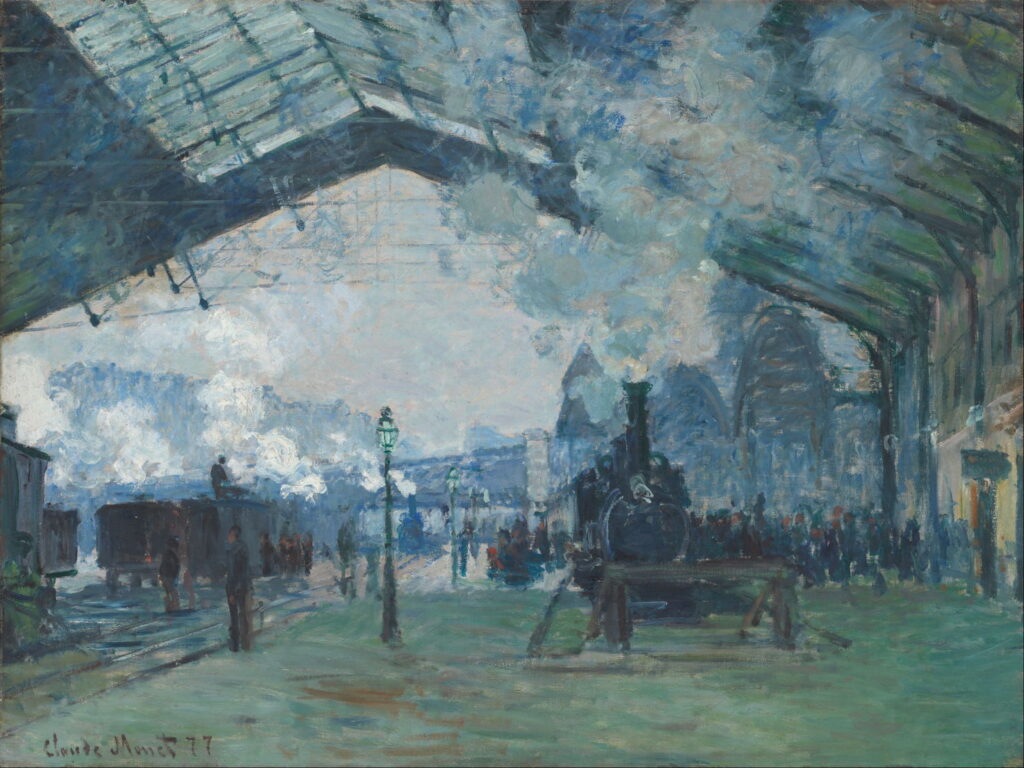All aboard: a century of painting railways 1

The nineteenth century brought huge changes in technology and society. Some, like telegraphy, telephones and radio, haven’t featured in many paintings, and even the bicycle has largely escaped the canvas. But the advent of railways, and later motor cars, had greater impact on visual art. In this weekend’s two articles, I trace the first century of railways in paintings from the early 1840s.
Joseph Mallord William Turner (1775-1851), Rain, Steam, and Speed – The Great Western Railway (1844), oil on canvas, 91 x 121.8 cm, The National Gallery (Turner Bequest, 1856), London. Courtesy of and © 2018 The National Gallery, London.
JMW Turner was among the first painters to capture this in his Rain, Steam, and Speed – The Great Western Railway in 1844. This pioneering railway connected London with rich farming country across the south of England, down into western counties, eventually reaching Cornwall in 1859, fifteen years after Turner completed this painting, and eight years after his death.
William Powell Frith (1819–1909), engraved by Francis Holl (1866) The Railway Station (1862), original oil on canvas, this print mixed media engraving on wove, finished with hand colouring, 66 x 123 cm, Private collection. Wikimedia Commons.
William Powell Frith’s The Railway Station (1862) captures the atmosphere of a major railway station in a capital city, here Paddington Station in London, by coincidence Brunel’s terminus for his Great Western Railway. Stations like this became a focus of activity, emotional partings and arrivals, migration, and a fair bit of crime too, everything the narrative painter might wish for.
Britain may have been the first to build railways, but the mania spread like wildfire across Europe and North America.
William Hahn (1829–1887), Southern Pacific R.R. Station at Sacramento (c 1873-74), oil on canvas, 64.7 × 94.6 cm, location not known. Wikimedia Commons.
As the railroad, it started to cover the far greater distances of the USA and Canada. William Hahn’s Southern Pacific R.R. Station at Sacramento (c 1873-4) shows its rapid growth there.
Smoke, steam and other atmospheric effects brought inspiration to the French artists who were developing painting from where Turner’s death had left it.
Édouard Manet (1832–1883), Le chemin de fer (The Railway) (1873), oil on canvas, 93.3 × 111.5 cm, The National Gallery of Art, Washington, DC. Wikimedia Commons.
France had been an early innovator and adopter, although such post-classical motifs wouldn’t have been appropriate for the Salon, of course. It took Édouard Manet painting his favourite model Victorine Meurent, in Le chemin de fer (The Railway) (1873), to break the ice. Its background is the Gare Saint Lazare in Paris. This painting was completed and sold in 1873 to the singer and avid collector Jean-Baptiste Faure, and astonishingly was the only painting accepted of three submitted to the Salon by Manet the following year, where it provoked outrage and ridicule, and a torrent of sarcastic cartoons in the press.
Giuseppe De Nittis (1846–1884), The Passing of a Train (between 1869 and 1880), oil on canvas, 31.1 x 37.6 cm, Private collection. Wikimedia Commons.
Near Manet’s painting in the Salon, a couple of works by Giuseppe De Nittis were given a warmer reception. Yet sometime between 1869 and 1880, De Nittis painted The Passing of a Train, his unashamed comment on the coming of the train.
As De Nittis, Monet, Pissarro, and the other Impressionists started painting in even more unacceptable styles around Paris, trains and railways came to appear even more.
Claude Monet (1840–1926), The Railway Bridge at Argenteuil (1873), oil on canvas, 60 × 99 cm, Private collection. Wikimedia Commons.
Claude Monet’s The Railway Bridge at Argenteuil (1873) is one of his several landscapes centred on the railway from the years immediately after the Franco-Prussian War. At this time, Monet was a regular commuter by train: when he, Camille and his son moved out to Argenteuil at the end of 1871, he travelled the short distance into Paris by train.
Claude Monet (1840–1926), The Railway Bridge at Argenteuil (1874), oil on canvas, 54 × 71 cm, Musée d’Orsay, Paris. Wikimedia Commons.
Monet liked this bridge so much that he painted it again the following year, in The Railway Bridge at Argenteuil (1874).
By the last quarter of the nineteenth century, steam power had become so essential to modern life it was assimilated into the everyday. Paul Cézanne’s family estate in Aix-en-Provence was connected by rail to Paris by 1856, and express trains to the Mediterranean coast enabled many artists whose studios were in the capital to paint in the remarkable light of the Midi. The prominent light ochre structure sweeping across many of Cézanne’s views of Mont Saint-Victoire is the long viaduct built to accommodate the railway that transported artists between Paris and the coast of the Midi.
Claude Monet (1840–1926), Arrival of the Normandy Train, Gare Saint-Lazare (1877), oil on canvas, 59.6 x 80.2 cm, Art Institute of Chicago, Chicago, IL. Wikimedia Commons.
In 1877, Claude Monet became the most painterly railway buff of them all. By then, he was becoming detached from Argenteuil, and sought a new radically modern urban theme. Where more appropriate than the steaming hubbub of the Gare Saint Lazare? Caillebotte paid the rent for him on a small studio nearby, and Monet gained approval to paint in the station. By the third Impressionist Exhibition of April 1877, Monet had assembled seven views of the station, including one that even seemed to please the critics. Among the paintings from that campaign is his Arrival of the Normandy Train, Gare Saint-Lazare (1877).
Claude Monet (1840–1926), Train Tracks at the Saint-Lazare Station (1877), oil on canvas, 60.5 × 81.1 cm, Pola Museum of Art, Hakone, Kanagawa, Japan. Wikimedia Commons.
Monet was too smitten to stop in the station, though. In his Train Tracks at the Saint-Lazare Station (1877) he reversed the view and started showing railway signalling.
Claude Monet (1840–1926), Saint-Lazare Station, the Western Region Goods Sheds (1877), oil on canvas, 60 × 80 cm, Private collection. Wikimedia Commons.
He went even further in his Saint-Lazare Station, the Western Region Goods Sheds (1877), showing the working parts with the smoky city beyond.

